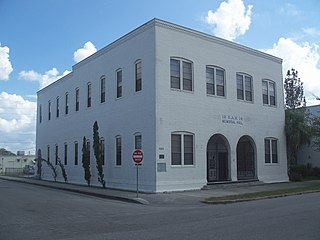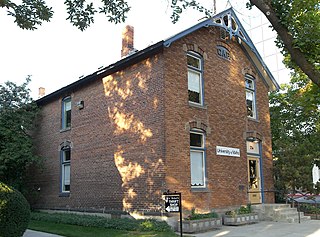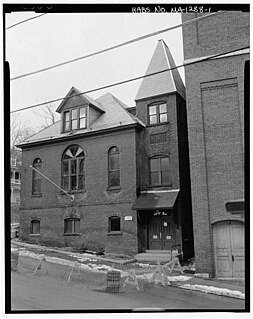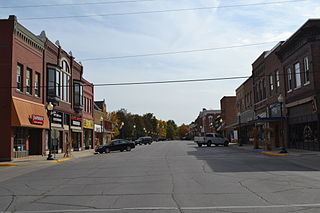
The Grand Army of the Republic (GAR) was a fraternal organization composed of veterans of the Union Army, Union Navy, and the Marines who served in the American Civil War. It was founded in 1866 in Springfield, Illinois, and grew to include hundreds of "posts" across the nation. It was dissolved in 1956 at the death of its last member, Albert Woolson (1850–1956) of Duluth, Minnesota.

The Grand Army of the Republic Memorial Hall is an historic building located at 1101 Massachusetts Avenue in St. Cloud, Florida, in the United States. The city of St. Cloud had been founded by the Grand Army of the Republic or GAR, as a retirement colony for its members. The hall was built in 1914 by members of the GAR as a memorial to the Union Army veterans of the Civil War. It was one of many such halls built in the country. On February 21, 1997, it was added to the U.S. National Register of Historic Places.
Grand Army of the Republic Hall, GAR Building, or variants thereof, may refer to:

The Grand Army of the Republic Hall is an historic building located at 34 School Street in Rockland, Massachusetts, in the United States. The hall was designed by local builder William Harrison Hebberd, andbuilt in 1899 by members of the GAR as a memorial to the Union Army veterans of the Civil War. It is a somewhat plainly decorated two-story wood frame building with a hip roof. Its most elaborate exterior feature is the main entry, a porch supported by clusters of narrow columns, and with brackets in its eaves. The interior is more elaborately decorated, and has retained most of its original Queen Anne details.

The Grand Army of the Republic Hall is an historic Grand Army of the Republic building located at 714 W. State Street in Boise, Idaho.

The Clearwater Masonic and Grand Army of the Republic Hall is a historic building in Clearwater, Minnesota, United States, constructed in 1888. It has served as a meeting hall for both a local Grand Army of the Republic (GAR) post, and a local Masonic Lodge, with commercial space on the ground floor. It was listed on the National Register of Historic Places in 1979 under the name Clearwater Masonic Lodge–Grand Army of the Republic Hall for having local significance in the themes of architecture and social history. It was nominated for its association with the fraternal organizations of Clearwater and many other rural Wright County communities that, in the words of historian John J. Hackett, "provided leadership, direction, and contributions to the county's political, educational, patriotic, and social life."

The Grand Army of the Republic Memorial Hall, also known as William Baumer Post No. 24, Grand Army of the Republic (GAR), and as the Civil War Veterans Museum, is a historic building located at 908 1st Corso in Nebraska City, Nebraska, in the United States. The hall was built in 1894–95. In 1994, it was added to the U.S. National Register of Historic Places.

The Grand Army of the Republic Hall, also known as the General Frederick W. Lander Post No. 5, Grand Army of the Republic, is an historic building located at 58 Andrew Street in Lynn, Massachusetts, in the United States.

The Grand Army of the Republic Hall is an historic building located at 23 East Downer Place on Stolp Island in Aurora, Illinois, in the United States.

Grand Army of the Republic Hall, also known as the Grand Army of the Republic Memorial Hall, was an historic brick building located at 14 Prospect Street in Orange, Massachusetts in the United States. The hall was built by members of the GAR as a memorial to the Union Army veterans of the Civil War. It was one of many such halls built in the country. It is a contributing property in the Orange Center Historic District.

The Lothrop Memorial Building-G.A.R. Hall is an historic building located at 95 Washington Street in Taunton, Massachusetts. It was originally built in 1888 as the First Presbyterian Church, on land purchased from Marcus Morton, and now houses professional offices. It was for many years home to the William H. Bartlett GAR Post No. 3 of the Grand Army of the Republic, a veterans organization, which ran the building as a community center. It was added to the National Register of Historic Places in 1984.

The G.A.R. Hall and Museum is a historic museum at 58 Andrew Street in Lynn, Massachusetts.

The Stephenson Grand Army of the Republic Memorial, also known as Dr. Benjamin F. Stephenson, is a public artwork in Washington, D.C. honoring Dr. Benjamin F. Stephenson, founder of the Grand Army of the Republic, a fraternal organization for Union veterans. The memorial is sited at Indiana Plaza, located at the intersection of 7th Street, Indiana Avenue, and Pennsylvania Avenue NW in the Penn Quarter neighborhood. The bronze figures were sculpted by J. Massey Rhind, a prominent 20th-century artist. Attendees at the 1909 dedication ceremony included President William Howard Taft, Senator William Warner, and hundreds of Union veterans.

The Hampton Double Square Historic District is a historic district located in Hampton, Iowa, United States. It has been listed on the National Register of Historic Places since 2003. At the time of its nomination it contained 43 resources, which included 28 contributing buildings, two contributing sites, 10 non-contributing buildings, one non-contributing site, one non-contributing structures, and on non-contributing object. The town of Hampton was laid out by H.P. Allen, who was the county surveyor, in June 1856. The original plat was eight blocks by eight blocks in the shape of an “L”. Near the center of the “L” was the two-block, or double, square. While many county seats in Iowa have a courthouse square, the double square is a rarity. Four double squares were platted in Iowa, but only those in Hampton and Sidney survived their early period of development. Estherville's square was platted as a four-block square, but its development created a double square instead. Hampton has the only symmetrical double square plan in the state. The double square exemplifies the two primary functions of a public square, both commercial and public development.

The Grand Army of the Republic Memorial Hall, built in 1892, is an historic building located at 401 Railroad Street in Ironton, Ohio. Designed by noted Ohio architect Joseph W. Yost in the Richardsonian Romanesque style of architecture, it was built to serve as a Grand Army of the Republic memorial and the meeting hall of Dick Lambert Post No. 165 of the GAR. It later served as the meeting hall of the now long-defunct American Legion Post No. 59 as well as the Ironton city hall. After being abandoned by the city, American Legion Post No. 433 undertook the task of restoring the long neglected veteran's memorial. On September 19, 2012, the building was added to the National Register of Historic Places. On May 28, 2014, demolition of the building began.

The Black Hawk County Soldiers Memorial Hall, also known as Veterans Memorial Hall, is a Classical Revival veterans hall located at 194 West Fifth Street in downtown Waterloo, Black Hawk County, Iowa. It was built from 1915 to 1916 by the Grand Army of the Republic as a memorial to soldiers who died in the American Civil War. It was listed on the National Register of Historic Places in 1988 due to its architecture and importance in local history.

Sac City Monument Square Historic District is a nationally recognized historic district located in Sac City, Iowa, United States. It was listed on the National Register of Historic Places in 2015. The square consists of the General Sherman Hall (1892), Memorial Statue (1894), the American Legion Hall (1922), four World War II era Howitzers, and three granite tablets that commemorate the lives of the soldiers from Sac County who fought in World War I, World War II, the Korean War, and the Vietnam War. The Vietnam War tablet does not contribute to the historic district because it is a more recent installation.


















